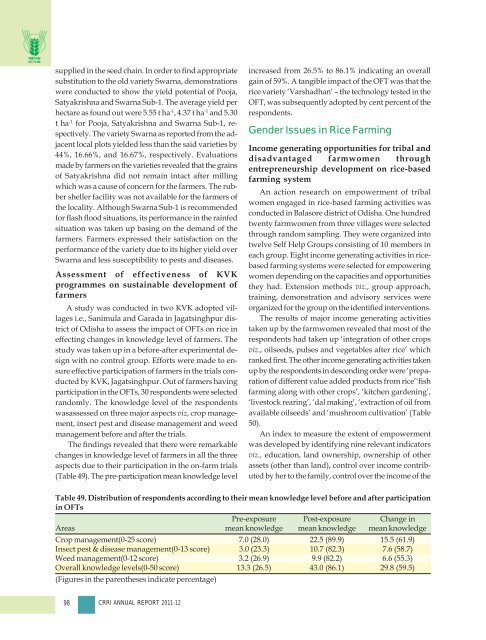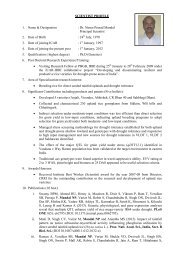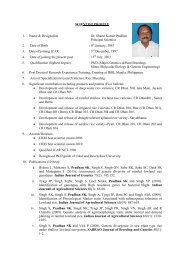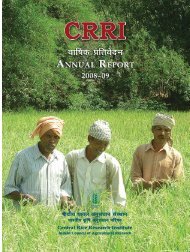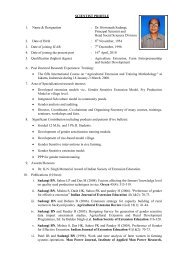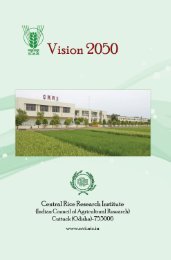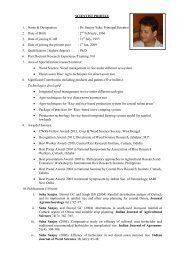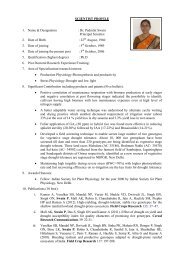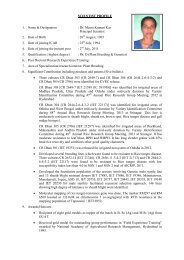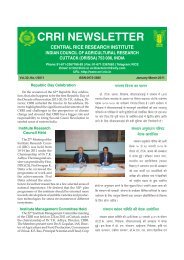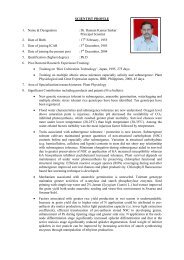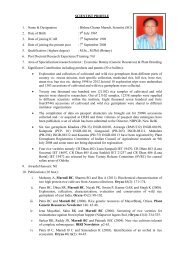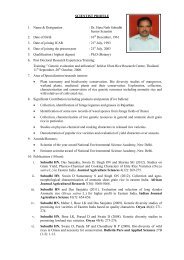Central Rice Research Institute Annual report...2011-12
Central Rice Research Institute Annual report...2011-12
Central Rice Research Institute Annual report...2011-12
Create successful ePaper yourself
Turn your PDF publications into a flip-book with our unique Google optimized e-Paper software.
supplied in the seed chain. In order to find appropriate<br />
substitution to the old variety Swarna, demonstrations<br />
were conducted to show the yield potential of Pooja,<br />
Satyakrishna and Swarna Sub-1. The average yield per<br />
hectare as found out were 5.55 t ha -1 , 4.37 t ha -1 and 5.30<br />
t ha -1 for Pooja, Satyakrishna and Swarna Sub-1, respectively.<br />
The variety Swarna as <strong>report</strong>ed from the adjacent<br />
local plots yielded less than the said varieties by<br />
44%, 16.66%, and 16.67%, respectively. Evaluations<br />
made by farmers on the varieties revealed that the grains<br />
of Satyakrishna did not remain intact after milling<br />
which was a cause of concern for the farmers. The rubber<br />
sheller facility was not available for the farmers of<br />
the locality. Although Swarna Sub-1 is recommended<br />
for flash flood situations, its performance in the rainfed<br />
situation was taken up basing on the demand of the<br />
farmers. Farmers expressed their satisfaction on the<br />
performance of the variety due to its higher yield over<br />
Swarna and less susceptibility to pests and diseases.<br />
Assessment of effectiveness of KVK<br />
programmes on sustainable development of<br />
farmers<br />
A study was conducted in two KVK adopted villages<br />
i.e., Sanimula and Garada in Jagatsinghpur district<br />
of Odisha to assess the impact of OFTs on rice in<br />
effecting changes in knowledge level of farmers. The<br />
study was taken up in a before-after experimental design<br />
with no control group. Efforts were made to ensure<br />
effective participation of farmers in the trials conducted<br />
by KVK, Jagatsinghpur. Out of farmers having<br />
participation in the OFTs, 30 respondents were selected<br />
randomly. The knowledge level of the respondents<br />
wasassessed on three major aspects viz, crop management,<br />
insect pest and disease management and weed<br />
management before and after the trials.<br />
The findings revealed that there were remarkable<br />
changes in knowledge level of farmers in all the three<br />
aspects due to their participation in the on-farm trials<br />
(Table 49). The pre-participation mean knowledge level<br />
increased from 26.5% to 86.1% indicating an overall<br />
gain of 59%. A tangible impact of the OFT was that the<br />
rice variety ‘Varshadhan’ – the technology tested in the<br />
OFT, was subsequently adopted by cent percent of the<br />
respondents.<br />
Gender Issues in <strong>Rice</strong> Farming<br />
Income generating opportunities for tribal and<br />
disadvantaged farmwomen through<br />
entrepreneurship development on rice-based<br />
farming system<br />
An action research on empowerment of tribal<br />
women engaged in rice-based farming activities was<br />
conducted in Balasore district of Odisha. One hundred<br />
twenty farmwomen from three villages were selected<br />
through random sampling. They were organized into<br />
twelve Self Help Groups consisting of 10 members in<br />
each group. Eight income generating activities in ricebased<br />
farming systems were selected for empowering<br />
women depending on the capacities and opportunities<br />
they had. Extension methods viz., group approach,<br />
training, demonstration and advisory services were<br />
organized for the group on the identified interventions.<br />
The results of major income generating activities<br />
taken up by the farmwomen revealed that most of the<br />
respondents had taken up ‘integration of other crops<br />
viz., oilseeds, pulses and vegetables after rice’ which<br />
ranked first. The other income generating activities taken<br />
up by the respondents in descending order were ‘preparation<br />
of different value added products from rice’‘fish<br />
farming along with other crops’, ‘kitchen gardening’,<br />
‘livestock rearing’, ‘dal making’, ‘extraction of oil from<br />
available oilseeds’ and ‘mushroom cultivation’ (Table<br />
50).<br />
An index to measure the extent of empowerment<br />
was developed by identifying nine relevant indicators<br />
viz., education, land ownership, ownership of other<br />
assets (other than land), control over income contributed<br />
by her to the family, control over the income of the<br />
Table 49. Distribution of respondents according to their mean knowledge level before and after participation<br />
in OFTs<br />
Pre-exposure Post-exposure Change in<br />
Areas mean knowledge mean knowledge mean knowledge<br />
Crop management(0-25 score) 7.0 (28.0) 22.5 (89.9) 15.5 (61.9)<br />
Insect pest & disease management(0-13 score) 3.0 (23.3) 10.7 (82.3) 7.6 (58.7)<br />
Weed management(0-<strong>12</strong> score) 3.2 (26.9) 9.9 (82.2) 6.6 (55.3)<br />
Overall knowledge levels(0-50 score) 13.3 (26.5) 43.0 (86.1) 29.8 (59.5)<br />
(Figures in the parentheses indicate percentage)<br />
98 CRRI ANNUAL REPORT 2011-<strong>12</strong>


